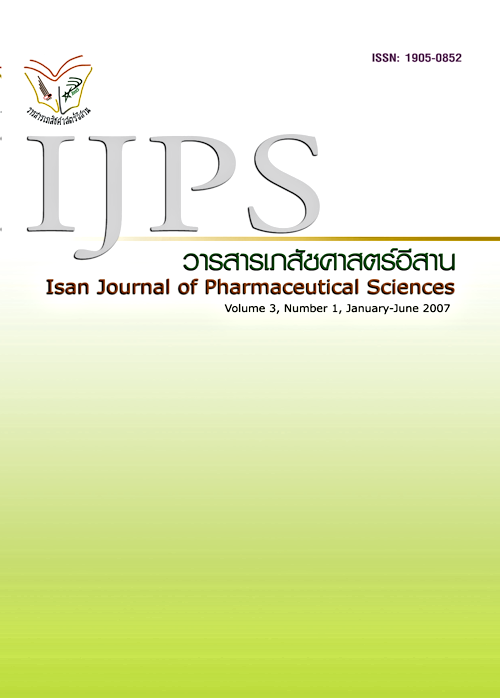Antimicrobial Activity of Biological Fermented Products from Northeastern Thai Indigenous Vegetables
Main Article Content
Abstract
Biological fermented products are obtained from the fermentation of vegetables, fruits and sugar mediated by microorganisms. The objective of this research was to study the antimicrobial activity of three biological fermented products derived from Northeastern Thai vegetables, namely Careya sphaerica Roxb., Cratoxylum formosumDyer and Eugenia grata(Wight) S.N. Mitra var. gratum. Each of them was prepared according to the local wisdom process. After 1 month of fermentation, the products were investigated for antimicrobial activity against 7 microorganisms, i.e. Bacillus subtilis, Staphylococcus aureus, Staphylococcus epidermidis, Escherichai coli, Salmonella typhi, Pseudomonas aeruginosa and Candida albicansby agar disc diffusion method. The antimicrobial activity of the aqueous extracts of these plants was also compared. Results showed that the biological fermented product and the extract of C. sphaericahad the effect on B. subtilis, S. aureus,and S. typhi,while the biological fermented product of C. sphaerica had the additional effect on E. coliand P. aeruginosa.Both the biological fermented product and the extract of E. gratahad the activity against S. typhi, but the former showed more inhibitory activity on B. subtilisand S. aureus.The extract of C. formosumhad the activity on S. aureusbut its biological fermented product did not. From the present, it is likely to conclude that the biological fermented products of Northeastern Thai vegetables that showed the appreciably antimicrobial activity were C. sphaericaand S. gratum,respectively. In detection of the fermentation participating microorganism, Lactobacillus caseiwas found and it existed in the products for about 2-3 weeks of fermentation. These biological fermented products were in the absence of microbial pathogens e.g., S. aureus, E. coli, S. typhi andClostridium perfringens.However fungi were over the limit.
Article Details
In the case that some parts are used by others The author must Confirm that obtaining permission to use some of the original authors. And must attach evidence That the permission has been included
References
Buckenhuskes HJ. 1993. Selection criteriafor lactic acid bacteria to be used asstarter cultures for various food commodi-ties. FEMS Microbiol Rev 12: 253-271.
Gilliland SE. 1986. Concentrated starter cultures.In: bacterial starter cultures for foods, ed.SE Gilliland. CRC Press Inc. Boca Raton,Florida: 145-157.
Jorgensen J, Turnidge J, Washington J. 1999.Antibacterial susceptibility tests: Dilutionand disk diffusion methods. In Murray PR,Baron EJ, Pfaller MA, Tenover FC, YolkenRH. Editors. Manual of clinical micro-biology, 6th ed. Washington DC: ASM Press:1526-1543.
Marshall VM. 1987. Lactic acid bacteria : startersfor flavour. FEMS Microbiol Rev: 46:327-336.
Thunell RK, Sandine WE. 1986. Types of startercultures. In: bacterial starter culturesfor foods, ed. SE. Gilliland. CRC Press Inc.Boca Raton, Florida: 127-144.


